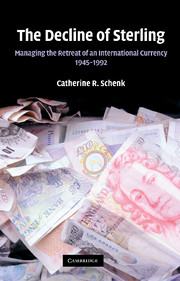Book contents
- Frontmatter
- Contents
- List of figures
- List of tables
- Acknowledgements
- 1 Introduction
- Part I Reconstructing the International Monetary System 1945–1959
- Part II Accelerating the Retreat: Sterling in the 1960s
- Part III Sterling's Final Retreat 1970–1992
- 9 Sterling and the end of Bretton Woods
- 10 Years of crisis 1973–1979
- 11 The aftermath 1980–1992
- 12 Summary and overview
- Index
9 - Sterling and the end of Bretton Woods
Published online by Cambridge University Press: 04 May 2010
- Frontmatter
- Contents
- List of figures
- List of tables
- Acknowledgements
- 1 Introduction
- Part I Reconstructing the International Monetary System 1945–1959
- Part II Accelerating the Retreat: Sterling in the 1960s
- Part III Sterling's Final Retreat 1970–1992
- 9 Sterling and the end of Bretton Woods
- 10 Years of crisis 1973–1979
- 11 The aftermath 1980–1992
- 12 Summary and overview
- Index
Summary
During the first half of the 1970s the pegged exchange rate system finally gave way to a less coherent system that combined floating, flexible and pegged rates. International financial flows accelerated rapidly and volatile commodity prices (including oil) added to inflation and slowing growth, which proved to be the greatest post-war challenge for policy-makers and economists. Britain abandoned the sterling peg before most others, in June 1972, but this did not mean that the Sterling Agreements became less important to managing sterling's reserve role, and they were maintained until the end of 1974. This chapter examines these years of crisis and transformation in the international monetary system.
The Nixon shock and the Smithsonian Agreement, August–December 1971
With the advent of the administration of Richard Nixon in 1969 came a new and harder line attitude from the US government over international monetary problems, which culminated in the ‘Nixon shock’ of August 1971. The new economic policy announced at this time marked the end of the American administration's willingness to engage in prolonged negotiations to reform the international monetary system, and the end of their acceptance of the pegged exchange rate system as a constraint on their economic policy. During his first years in power Nixon was convinced that the United States' economic problems were the result of an excessive international defence burden and protectionist policies by its creditors, which pushed the American balance of payments into persistent deficit.
- Type
- Chapter
- Information
- The Decline of SterlingManaging the Retreat of an International Currency, 1945–1992, pp. 317 - 356Publisher: Cambridge University PressPrint publication year: 2010



